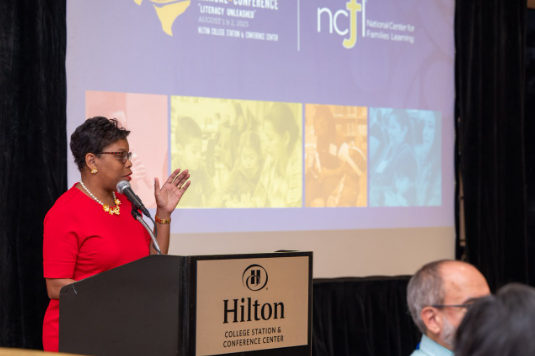At the Heart of Family Learning: The power and possibility of immersive technologies

Earlier this month, I was asked to provide the keynote address for the Literacy Texas Annual Conference in College Station, Texas. It was such an honor to speak with literacy professionals from across Texas and to see firsthand their commitment to and support of adult learners. I was also truly inspired by the conference theme: Literacy Unleashed. As students and educators across the country begin a new school year, I am pondering what it would look like in practice for us as educators and literacy providers to engage more deeply in innovative practices and design learning experiences that spark creativity? What new ideas and technologies might we embrace to enhance literacy and learning outcomes? Learners – birth through adulthood – need these types of experiences in classrooms, out-of-school contexts, and community learning spaces.
It’s an exciting and daunting challenge considering the dizzying pace of technological change. But there are some immersive technologies – including Virtual Reality (VR) and Artificial Intelligence (AI) – that have shown promise. This topic has captivated blogs, articles, and news media, especially over the past year. Our challenge as professionals will be in using those technologies as tools to help learners achieve their education and career goals while ensuring that families furthest from opportunity are not left behind.
Virtual Reality (VR) has already demonstrated some efficacy as a learning tool, bringing experiences that would otherwise be out of reach into the classroom. Students can tour the International Space Station or explore the inside of a volcano all without ever leaving their classrooms. A 2021 overview of the use of immersive technologies in education by the Information Technology and Innovation Foundation noted a host of potential student benefits, including “higher engagement and improve[d] memory recall for complex or abstract topics”.
Artificial Intelligence (AI) is another growing field making rapid advances into the education space. While popular tools like ChatGPT capture headlines, AI is a quiet force behind many online education tools, providing personalized learning opportunities tailored to a particular student’s knowledge level and learning speed. On the homefront, the technology is even more ubiquitous. Students and families interact with AI to foster learning in various ways such as voice-to-text applications that support literacy and language acquisition and through the use of machine learning to create adaptive learning paths. At NCFL, we are exploring ways AI can be beneficial to adult learners in family literacy programs across the country. We’re listening closely to our partners as this innovation begins to show promising practices for tutoring supports, language enhancements, and informal and local research endeavors. Digital literacy skills have become increasingly necessary, causing policymakers around the country to pause and explore the importance of adopting strong policies to protect and engage learners across the age continuum.
The stakes are undoubtedly high. But new technologies and multiple literacies – including digital literacy – are not optional in today’s global economy. It is incumbent on us as education and literacy professionals to consider what materials we are using to prepare learners for the many different modalities of text they are encountering. We have all transitioned from exclusively reading from the printed page to reading from a wide variety of modalities on a daily basis. How do our learning environments reflect these shifts? Our practices must catch up with the innovations in the field, even as they proceed with some cautions.
The digital divide in education has been a concern since the mid-1990’s when the U.S. National Telecommunications and Information Administration first published a report on the ways in which the growth of the internet was leaving some populations behind. But the ways in which the digital divide impacts children and families continues to evolve. While the gap between internet users and non-users – known as the first level digital divide – has narrowed, inequalities in digital skills and usage (the second-level digital divide) persist. But even when internet access and usage are equal across groups, research has shown that the benefits of that access are not evenly distributed. This third-level digital divide makes clear that the tangible outcomes of both the internet and the new technologies it has given rise to are far from assured, likely due at least in part to many of the same inequities that disenfranchised communities face in other parts of their lives.
The persistence and depth of the digital divide is daunting, but there are solutions. Interestingly, AI itself may hold some of the answers. In a recent article on the Getting Smart blog, guest author Dr. Kara Stern challenged educators to use ChatGPT as a tool to help incorporate student and parent point of view into the learning equation. “What if we asked ChatGPT to think like the populations we’re serving,” Stern asks, “as a way of improving the education…we’re delivering?” What if, instead of fearing the ways in which AI might upset the instructional paradigm, we instead embraced it as a tool to visualize and overcome our own biases and preconceptions?
_13.jpg)
These are the very questions we’re grappling with at NCFL. Our mission is to spread and scale education solutions for families. We’re focused on partnering with organizations to explore innovations in the field and engaging families in learning together around new tools and practices – all while maintaining a keen focus on ensuring that the benefits of access are evenly distributed to all families.
NCFL will be highlighting the multi-faceted topic of emerging technology in education during our upcoming 2023 Families Learning Conference in Omaha, happening October 23-25. Emergent technologist and humanitarian Christopher Lafayette will join us on the mainstage in Omaha to discuss ways to include humanity itself in the conversation about the intertwining of technology and human experience. We’ll also feature a robust panel discussion highlighting the work being done around the country to foster digital equity and resilience, with expert commentary from World Education Vice President Priyanka Sharma, Digital Promise Chief Digital Equity Officer D’Andre Weaver, and Chapman University School of Communications Professor and NCFL Board Member, Vikki Katz.
When we define the conditions that allow individuals to thrive, we can change the trajectory of adult and family learning. This will require us to unleash new ideas for learning and set up new contexts that are both relevant and captivating to underserved audiences. It’s an important journey, and it’s not one NCFL can undertake alone.
The promise and possibility of this time of year, with schools returning to session, is something I remember well from my time as an education and district and state administrator. I wish educators, students, and families a safe and productive start to the school year. And I challenge schools, education providers, civic leaders, and policy-makers to join with us in working to close the digital divide and equip communities and learners of all ages with educational tools that balance technology, opportunity, and equity.
ABOUT THE AUTHOR

A lifelong educator and national thought leader for teaching and learning, Dr. Felicia C. Smith brings decades of valuable experience to advance NCFL’s mission of working to eradicate poverty through education solutions for families. Having served in a variety of leadership roles in P-12, higher education, nonprofit, and philanthropy, her career has allowed her to experience leading systems and develop a unique vantage point of a learner’s educational trajectory from preschool to adulthood. Smith holds an Ed.D. in education leadership and administration from the University of Kentucky, and an M.A. in elementary education with an emphasis on K-12 literacy development and B.S. in elementary education from the University of Louisville.